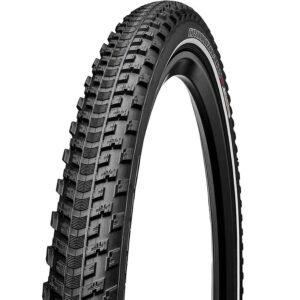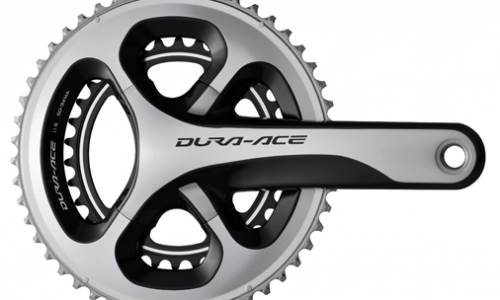Commuter bike tires have different demands than road or mountain bike tires. Commuters prioritize durability, longevity and puncture resistance even if this means a slightly heavier tire.
One of the best upgrades you can make to your commuter bike is tires, being your two contact points with the road, which means they have the largest effect on how your bike handles.
There is a wide range of excellent commuter tires on the market, and choosing the one most appropriate to your commute will depend on a number of considerations, including: distance of your commute, whether or not you often ride in rainy conditions, presence of puncture hazards on your roads, riding an e-bike, etc.
Below we have a look at some of the best commuter tires currently on the market, we then discuss key considerations when shopping for a tire upgrade for your commuter bike.
1. Continental Gatorskin

Road riders who train on rough roads love the Gatorskin for its excellent durability, and commuters who want a tough, low rolling resistance tire will like it for the same reasons. The Gatorskin comes with a reinforced sidewall and enhanced puncture protection.
The Gatorskin is not as puncture-resistant as other commuter tires, but it’s relatively low weight and fast rolling properties makes it a great tire for the commuter who wants a good balance between durability and speed.
2. Panaracer Ribmo

The Panaracer Ribmo features a 800D polyamide cord carcass which is further reinforced by a layer of PT shield fabric. In other words, the Ribmo is one tough tire.
Panaracer uses their hardest rubber compound, dubbed the Mile Cruncher, in the construction of the Ribmo. Despite its incredible toughness, the Ribmo rolls fairly fast on the road. You’ll need a strong set of tire levers to get these tires on your rims, though!
3. WTB Thickslick
 The WTB Thickslick is an urban tire with a thick casing and a, as the name implies, a super slick tread.
The WTB Thickslick is an urban tire with a thick casing and a, as the name implies, a super slick tread.
The Thickslick comes in two versions: Comp and Flat Guard, with the later adding two additional layers of rubber to enhance puncture resistance.
That bald tread gives it great rolling properties, but the additional layers of rubber come with a small weight penalty.
4. Schwalbe Marathon Plus Smart Guard
 The Schwalbe Marathon range of commuter tires come in a variety of tread patterns and construction options, including tubeless-ready versions.
The Schwalbe Marathon range of commuter tires come in a variety of tread patterns and construction options, including tubeless-ready versions.
The Marathon Plus Smart Guard version is a robust tire that’s rated for use on e-bikes. They have an impressive puncture resistance that make it a venerable tire of choice by hardcore bike commuters.
The secret to its legendary puncture resistance is a 5mm strip of rubber between the carcass and tread. This additional layer of rubber can withstand stabs from sharp road debris and keep you rolling trouble-free to your destination.
5. Specialized Crossroads Armadillo

If your commute route takes you on unpaved paths, gravel roads or some fun singletrack, the you should strongly consider the Specialized Crossroads Armadillo.
The tread pattern is reminiscent of XC mountain bike tires, with a low-profile center strip for speed and raised side knobs for cornering grip on loose terrain.
The Crossroads Armadillo also features a reinforced carcass, which improves puncture resistance on roads and trails.
6. Michelin Protek Urban Tire

The Michelin Protek would be an ideal choice if you often commute in wet weather. Michelin makes the Protek using the same rubber compound used their excellent Pro 4 Grip Service Course high-performance road tyres.
This rubber compound shines in wet conditions, sticking like glue to the slippery road surface while the minimal tread makes for a very fast rolling tire. The Protek features a wire bead, Aramid layer for puncture protection, a reflective sidewall and are suitable for use on e-bikes.
7. Continental Contact Plus

Another excellent commuter tire comes from the renowned German tire manufacturer, Continental. The Contact Plus come in an e-bike rated construction that combines low rolling resistance with superior puncture protection, which is a blend often hard to achieve.
They come in 26, 27.5 and 700C diameters and widths up to 700x42C, and have a Kevlar strip under the tread to deflect sharp objects.
8. Vittoria e-randonneur

Vittoria uses Graphene, an incredibly strong and light material, in the construction of its line of premium bike tires, including the urban/city focused e-randonneur tire.
This tire is rated for e-bike use, and has an extremely high puncture resistance that comes at a slight cost in an increase in rolling resistance.
If you have a relatively short commute on bad roads, or ride an e-bike, this might be the tire for you.
Some notes on what to look for when shopping for new commuter tires
1. What makes a good commuter tire?
Generally speaking you will want a minimum width of 28C, preferably 32-35C. Below this you’re in road racing territory, more prone to punctures and with a decreased ride comfort due to the very small volume. A tire with good traction and grip in all conditions would be ideal.
There is always a compromise between traction and rolling resistance, and most premium commuter tires strike a good balance between both.
Enhanced puncture resistance is essential if you don’t want to run late for work or spend your evening home commute fixing punctures. Features like reflective sidewalls enhance your visibility on the road, which is essential if you live in a crowded city and commute in the dark.
2. Tread patterns
Commuter tires come in slick, semi-slick or full tread. Slick tires maximize rolling efficiency and have minimal rolling resistance, but may sacrifice traction where road conditions are not ideal, or where tarmac turn into dirt or gravel paths.
Treaded tires come in a variety of tread patterns and profiles, from mountain bike-like aggressive tread patterns to an in-between tread similar to gravel or cyclocross tires.
Most commuters will benefit from treaded tires to be ready for a variety of road conditions, as well as the puncture-resistance properties the knobs and grooves in the tread might provide.
Buy the proper tire to suit your commute, especially if you ride on variable terrain or poor-quality roads.
Slick tires will offer poor grip if ridden on off-road. If you have any sections that are not smooth asphalt on your commute, go for tires with a treaded carcass. If you ride strictly on smooth tarmac, they you will be best served by a slick tire, which will provide excellent grip on the flat road surface especially when it rains.
3. Rubber compounds
 Rubber compounds play an important role in traction and grip. Softer compounds provide better grip but will have a much faster wear rate over hard compounds.
Rubber compounds play an important role in traction and grip. Softer compounds provide better grip but will have a much faster wear rate over hard compounds.
Several premium tires for commuting will be offered in a dual tread construction which combines a hard compound in the middle of the tread for durability, and a softer one on the sidewalls for cornering grip.
Again, there is always a compromise to accept and a “sweet spot” balance to be achieved with various tire rubber compounds, and this will largely depend on the kinds of roads you ride.
4. Width
Commuting tires are generally wider than road tires but narrower than mountain bike tires. This is because commuting tires should provide a better durability and all-conditions grip than road tires, but should not create unnecessary rolling resistance and carry excessive weight like mountain bike tires (which are designed for full-on off-road riding).
The higher the volume the more comfortable the tire is and the more traction over uneven surfaces it has. More air in the tire means a more cushioned ride, and the ability to run lower pressures means it can conform better to imperfections in the road, which results in an improved grip.
Check the maximum clearance for your frame, and then decide on an appropriate width to match your commute conditions. As mentioned, going lower than 28C will be too skinny for commuting, and higher than 35C will increase rolling resistance.
5. Weight vs puncture protection?
The more puncture protection the tire offers, the heavier it usually is due to the additional layers of rubber and protective materials the manufacturers adds to improve puncture resistance. Again, deciding on how much puncture protection you need depends on the conditions of the roads your commute takes you on.
If they’re strewn with broken glass, metal shards or otherwise aggressive road debris, a slight weight penalty in the tires is nothing compared to the peace of mind that you will get from a robust set of tires that will be less prone to damage from bad roads.
Final Thoughts
Sometimes a commuter bike is the beater bike. The thankless workhorse. The one you don’t care about it being banged up a little bit. Do not cheap out on your commuter tires, though. You only have two contact points with the ground, and those are your tires.
Poor quality commuting tires will be unreliable, make for an uncomfortable ride and will probably be unsafe to ride. There are many options for great commuter tires, and we listed some of the best in this article, so pick the ones that best match your commuting needs.

Hani Morsi is a seasoned multi-discipline cyclist with a particular liking for mountain and gravel bikes. Hani is also a mountain bike coach, trail builder and experienced bike mechanic.


